Final report for GW21-219
Project Information
Management of grape powdery mildew requires great financial, environmental, and public health costs due to a heavy reliance on fungicides (~89% of the fungicide active ingredient used in grape production). New pest management tools are needed to reduce the environmental effects of heavy fungicide use and mitigate the emergence and spread of fungicide resistance. Germicidal ultraviolet C light (UV-C) may provide a new management tool for the improved control of powdery mildew in grapes that addresses these goals. Our research has shown that powdery mildew isolates vary in their tolerance to UV-C, but the effective doses are within ranges that can be reached in field applications. Small plot research trials demonstrated that UV-C significantly reduces disease development with or without augmentation of fungicides and without impacting fruit quality. Although treatments of UV-C alone exceeded commercially acceptable disease levels, it is likely this is an artifact of plot-to-plot interference from the untreated controls. It is possible that the UV-C applications will be more effective in a commercial setting where disease pressure is lower and more realistic. This technology needs to be tested at a commercial scale and compared to current management practices. However, this is not likely to occur until autonomous application technology (e.g., self-driving devices) reaches the robustness required for long-term field use. Finally, research results and live demonstrations of the UV-C application arrays have been made in commercial vineyards at various grower and researcher meetings serving Oregon, Washington, and California. Virtual and in-person research presentations and demos were well attended and accounted for both growers, researchers, and other agricultural professionals. Survey results show a high level of knowledge gained at events by growers who participated in the survey, and at least eight growers immediately indicated that there is interest in incorporating the technology into their disease management practices. Ten others have reached out for design parameters and two have visited to examine our research unit array.
- Identify the UV-C radiation dose and timing required to inhibit the growth of Erysiphe necator (grape powdery mildew) and Botrytis cinerea (bunch rot).
- Determine the suitability of UV-C radiation applications, under field conditions, for the management of powdery mildew and Botrytis bunch rot disease and its impact on fungicide-resistant pathogen populations.
- Examine the suitability of an autonomous robotic platform to deliver UV-C applications at a commercial scale.
- Determine the impact of UV-C application on fruit chemistry
- Education and demonstration of the tractor-mounted and robotic UV-C arrays directly to producers
Efficacy trials under laboratory conditions are already underway and will continue through into year two. The field studies at the BPP research vineyard and WVV will start in April and end in September or October after which point the tests on the harvested fruit chemistry will begin and then end before the beginning of the next field season. Demonstrations will be held in spring and summer to show the arrays in an accurate field setting. Display of the UV-C applications units will also occur starting in Spring and continuing throughout the summer.

Cooperators
- (Researcher)
- - Technical Advisor - Producer
- - Technical Advisor (Researcher)
- (Researcher)
Research
To examine the utility of UV-C radiation for the management of grape powdery mildew and bunch rot, investigated the following objectives:
- Identify the UV-C radiation dose and timing required to inhibit the growth of Erysiphe necator (grape powdery mildew) and Botrytis cinerea (bunch rot).
- Determine the suitability of UV-C radiation applications, under field conditions, for the management of powdery mildew and Botrytis bunch rot disease and its impact on fungicide-resistant pathogen populations.
- Examine the suitability of an autonomous robotic platform to deliver UV-C applications at a commercial scale.
- Determine the impact of UV-C application on fruit chemistry.
- Education and demonstration of the tractor-mounted and robotic UV-C arrays directly to producers
Objective 1. Identify the UV-C dose and timing required to effectively manage grape powdery mildew and Botrytis bunch rot
Effect of UV-C dose on conidia germination. Single conidium Erysiphe necator isolates were grown on detached grape leaves until sporulating (~10-14 days old) in a growth chamber at 21°C with a 16-hour photoperiod. Conidia deposited to Gelzan gum in a 24-well plate by puffing air onto the colony in a settling tower and allowing conidia to settle for 5 minutes.
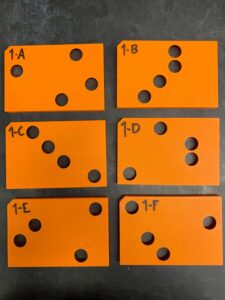
Single conidium Botrytis spp. isolates were grown on potato dextrose agar amended with streptomycin (SPDA) for 10 days at 20°C under 16 hr. photoperiod of blacklight and fluorescent light to promote sporulation. Conidia were harvested by adding 3 mL of 0.05% Tween 20 and gently rubbing the culture with a sterile loop. Conidia were filtered through sterile cheesecloth and adjusted to 10,000 conidia per mL.
Conidia or germlings were incubated in the dark for 1 hour before being exposed to six doses of UV-C (including control) ranging from 0 to around 600 Joules per square meter (J/m2). Four wells were arbitrarily selected for each treatment and other wells protected with 3D printed plate lids (Figure 1). To mimic how UV-C radiation was supplied in the field, two 16 in. 36-watt UV-C compact fluorescent lamps (GPL36K, Ushio) inside a retrofitted greenhouse lamp housing lined with aluminum foil and fitted with curtains of reflective foil placed over a conveyer belt (Figure 2). This system allows the dosage to be controlled by both the distance from the lamps to the sample and the speed of the sample passing under the lamps. To control which wells of the plate were exposed and protect the others, custom lids were 3D printed with gaps exposing only the desired wells. After exposure to UV-C radiation, the plates were incubated at 21°C for a darkness period of 7 hours, returning to the 16-hour photoperiod for 48 hours before being imaged with an Echo Revolve digital microscope (Figure 3). The images were processed in ImageJ software to estimate the amount of germination in each well. Each dose of UV-C was applied to four wells on each plate, growth was averaged across the wells and dose-response curves were created in R using the ‘drc’ package to estimate the half-maximal inhibitory dose (ED50) of UV-C to inhibit germination of powdery mildew and Botrytis conidia compared among isolates with different fungicide resistance profiles.
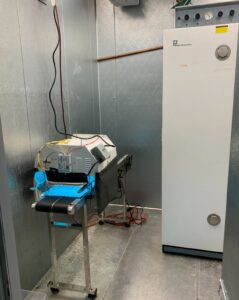

Botrytis growth was measured by inoculating each well of a Gelzan gum media in 24-well plates with a 1 µL drop of 10,000 conidia per milliliter in a 0.05% Tween 20 solution (10 conidia). Plates were incubated at 20°C and 16-hour photoperiod, and the plates were exposed to UV-C 0-600 J/m2 after an hour of darkness at the time of inoculation and 24 hours later. The wells were stained with 50 µL of 0.01% florescent calcofluor in 1X PBS to stain fungal chitin and rinsed with 100 µL 1X PBS. The plate was fluorescently imaged 48 hours after inoculation using a DAPI filter set with the ECHO Revolve digital microscope, and the mycelial network was mapped using the software “Fungal Feature Tracker” (Vidal-Diez de Ulzurrun, G., 2019) to determine colony growth (Figure 4) by hyphal length. Each dose of UV-C was applied to four wells on each plate, growth was averaged across the wells and two-parameter log-logistic dose-response curves were created in R using the ‘drc’ package to estimate the half-maximal inhibitory dose (ED50) of UV-C to inhibit growth.
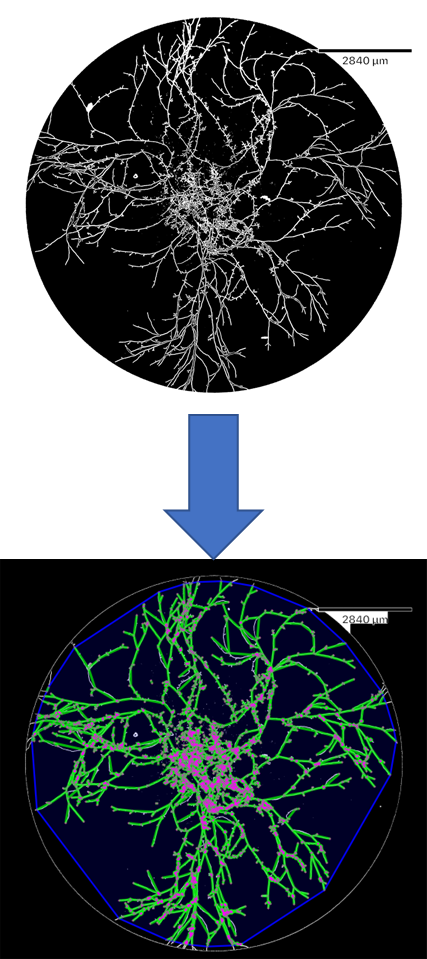
Objective 2. Determine the suitability of UV-C radiation applications, under field conditions, for the management of powdery mildew and Botrytis bunch rot disease and its impact on fungicide-resistant pathogen populations.
Disease and resistance management of UV-C application. A small plot experiment using the tractor-mounted UV-C array (Figure 5) was performed at the Botany and Plant Pathology research vineyard in Corvallis, OR. The vineyard consists of vertical shoot positioning trained Pinot Noir vines. The experimental design was a split-plot design with three replications in a randomized complete block. The UV-C array consists of 24, 55-Watt, 3 ft. fluorescent UV-C lamps (Sylvania Osram G55T8) with entire rows receiving an estimated UV-C dose of 0 J/m2, 48 J/m2 or 72 J/m2 once a week in 2020, and 0 J/m2, 72 J/m2 or 96 J/m2 twice a week in 2021 and 2022. UV-C dose was adjusted using tractor ground speed. The five, 5-vine subplots within each row are managed with different fungicide programs. In 2020, subplots received an untreated control, 7 or 14-day interval sulfur (Microthiol; 5 lbs/A), 14-day interval QoI (Abound Azoxystrobin; 10 floz/A), and a 14-day alternation of sulfur and the QoI. In 2021 and 2022, subplots received an untreated control, 14-day interval sulfur (Microthiol; 2 lbs/A), 14-day interval sulfur (4 lbs/A), 21-day sulfur (4 lbs/A), and an alternation on a 14-day interval of sulfur (4 lb/A) and a QoI (Abound Azoxystrobin; 10 floz/A). In 2021 and 2022, treatment rows were separated by buffer rows treated with 14-day interval sulfur (4 lb/A) and either 72 or 96 J/m2 UV-C applied once a week. UV-C and fungicide treatments started at 6-inch shoot growth and ended at veraison (grape color change). In 2023, the design was increased to a 5 x 5 split plot design with once or twice weekly 72 or 96 J/m2 and the control as the UV-C treatments. Fungicide subplots were 14-day interval sulfur applied till color change, pea sized berries, or berry touch, as well an alternation of Abound and sulfur applied until color change, and finally, proposed photosensitizer agents Riboflavin and Tryptophan applied every 14-days at 50 g/A. When the photosensitizers were observed to not properly manage foliar mildew, an application of 5 floz/A of Rhyme (Flutriafol) and 5 lb/A sulfur was applied at bloom followed by sulfur every 14 days. Untreated check vines less than 100 meters away were rated as controls by proxy.
Powdery mildew leaf incidence was assessed every other week starting at 12-inch shoot growth and ending at veraison by randomly selecting ten leaves from each of the three center vines within each subplot (30 leaves rated per subplot). Swab samples were also taken of powdery mildew colonies found by raters by touching a cotton swab to discover colonies. In addition, gloves of the disease raters were swabbed, gloves rinsed with water, and dried after rating each subplot (Lowder et al. 2023). Cotton swabs were processed at the lab to extract DNA from the conidia collected and quantify the number of E. necator conidia (Thiessen et al. 2016) and the presence of alleles associated with fungicide resistance (Miles et al. 2021). At the start of veraison, severity ratings of mildew on 10 leaves and 10 clusters per vine were visually assessed from the middle three vines of each subplot. For leaves, the area of both the adaxial and abaxial sides was estimated using a reference scale. For clusters, the percentage area of the cluster with mildew infection was estimated using a reference scale.
To rate for bunch rot, 5 clusters from each of the middle three vines (15 total) of each subplot were randomly sampled at harvest, brought back to the lab, rated for bunch rot severity (Sanzani et al. 2012), then each cluster was placed in plastic planter tray cells, wrapped in a plastic trash bag, and put into a 20°C growth chamber and incubated in high humidity (85%) for 48 hours and rated again.
All data were analyzed using RStudio with mixed effect linear models to compare treatments for differences for a split plot design.
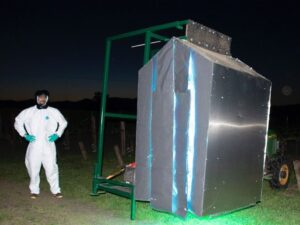
Objective 3. Examine the suitability of an autonomous robotic platform to deliver UV-C applications at a commercial scale.
Willamette Valley Vineyards purchased a SAGA robotics UV-C unit (Figure 6) which was delivered and assembled in April of 2021. Tests of the unit’s software, hardware, mobility, and autonomous platform were conducted on vineyard rows at Wilamette Valley Vineyards (WVV) and the Oregon State University Botany and Plant Pathology (BPP) vineyard. Deployment for field trials was attempted but the robotic command and control was found to be unsuitable for dealing with the rough terrain encountered in vineyards. The lack of physical “home” on the servos controlling wheel alignment resulted in loss of steering when an obstacle was encountered that caused any of the four independent wheels to be jerked. The wheels would remain out of alignment until manually calibrated. This severely limited the capabilities of the unit, and the trials could not be executed trials. We have been working with George Fox University and their Senior Design Program as well as Puren Solutions to reimagine the robotic system. Willamette Valley Vineyards is predicted to be receiving an autonomous tractor for the 2024 season which will hopefully carry the new array being designed.
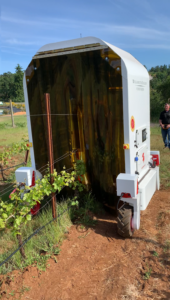
Objective 4. Determine the impact of UV-C application on fruit chemistry.
UV-C effects on fruit chemistry. At harvest, an additional 15 harvest-ready clusters were randomly sampled from the three center vines of each five-vine subplot at the Botany and Plant Pathology (BPP) site. Samples were stored at -80°C until they could be processed. Berries from clusters were randomly subsampled into three, 100-gram samples and thawed before being homogenized in a Waring blender on the highest setting for 2 minutes. Berry homogenate was centrifuged at 1730 x g for 10 minutes and the supernatant collected calculated soluble solids as degrees Brix with a refractometer, pH measured by a pH meter. Fruit anthocyanins and phenols were measured by acidic ethanol extraction of berry homogenate supernatant and were estimated using spectrophotometry to compare the no UV-C control treatments to the UV-C treated fruit (Bindon et al. 2014; Mercurio et al. 2007; Rantsiou et al. 2020). Samples for fruit chemistry were not taken of the untreated control vines in any year since the disease desiccated the berries and was not representative of realistic vineyard management.
Objective 1. Identify the UV-C dose and timing required to effectively manage grape powdery mildew and Botrytis bunch rot
For isolates of Erysiphe necator, the effective 50% inhibitory dose (ED50) of UV-C values varied across isolates from 85 to 394 J/m2 with an average of 246 J/m2 (Table 1). This assay measures the germination growth of the conidia, and not the pathogenicity or true viability of the conidia, so the ED50 to inhibit infection may be lower than reported here. Regardless, this assay can still show the relative differences across isolates. This variability in sensitivity may suggest that there may be cellular mechanisms that influence the tolerance or sensitivity of powdery mildew to UV-C. For Botrytis, conidia were considerably more tolerant to UV-C than the 24-hour germlings (Table 2). This may be due to the higher degree of melanin in conidia than in the growing germination tube, allowing the conidia to be more tolerant to UV-C. These lab studies suggest that UV-C doses to inhibit E. necator are obtainable in a field setting.
Table 1. The UV-C 50% inhibitory dose (ED50) values in Joules per square meter (J/m2) to inhibit E. necator isolate conidia germination normalized to the control.
|
Isolate name |
CYTB genotype y |
Origin |
Mean z ED50 ± std error |
|
AB1 |
G143 |
OR |
269 ± 28 CDE * |
|
LH2 |
G143 |
OR |
206 ± 25 BC |
|
MEN8B |
G143 |
CA |
143 ± 5 AB |
|
RMT2A |
G143 |
OR |
85 ± 5 A |
|
CAT1 |
A143 |
CA |
337 ± 23 DEF |
|
CAT1D1 |
A143 |
CA |
394 ± 33 F |
|
CL9-3 |
A143 |
OR |
361 ± 20 EF |
|
FC1A-2 |
A143 |
CA |
246 ± 22 BCD |
|
SE7A |
A143 |
OR |
173 ± 18 ABC |
|
y CYTB genotype assessed by allele specific TaqMan qPCR assay (Miles et al. 2021). G143 is the wild-type allele, and A143 is the quinone outside inhibitor resistance allele. z The average ED50 of three assays with two-parameter log-logistic dose response models created using the drc R package. * Means with the same letter are not significantly different using Tukey’s HSD for a group of nine estimates (α = 0.05). |
|||
Table 2. The UV-C 50% inhibitory dose (ED50) values in Joules per square meter (J/m2) to inhibit Botrytis isolate conidia germination and germling growth normalized to the control.
|
|
Mean x ED50 ± standard error |
|
|
Isolate name |
Conidia y |
Germling z |
|
ARC-21-3 |
187 ± 10 C * |
56 ± 18 A |
|
BPP-20-704 |
153 ± 5 BC |
26 ± 1 A |
|
OAS-22-5 |
131 ± 9 B |
16 ± 9 A |
|
OAS-22-21 |
110 ± 5 B |
27 ± 7 A |
|
x The average ED50 of three replications from two-parameter log-logistic dose response models created using the drc R package. y 1 µL of freshly harvested conidia (10,000 conidia/mL), pipetted onto media filled 24-well plates, incubated in darkness for one hour prior to UV-C treatment, and imaged 48 hours after inoculation. z Twenty-four-hour old, germinated conidia on media filled 24-well plates, incubated in darkness for one hour prior to UV-C treatment, and imaged 48 hours after inoculation. * Means with the same letter are not significantly different using Tukey’s HSD for a group of eight estimates (α = 0.05). |
||
Objective 2. Determine the suitability of UV-C radiation applications, under field conditions, for the management of powdery mildew and Botrytis bunch rot disease and its impact on fungicide-resistant pathogen populations.
In all years of the small plot study, UV-C significantly reduced the foliar powdery mildew (AUDPC) as compared to the no UV-C control vines (Figure 7). In 2020, 2021, and 2023, UV-C had a significant effect on the fruit powdery mildew severity (Figure 8 and 9) as compared to the no UV-C exposed vines. The effect of fungicide was significant for all disease metrics in all years of the study with the interaction effect between fungicide and UV-C only being significant in 2023 for fruit severity (Figure 9).
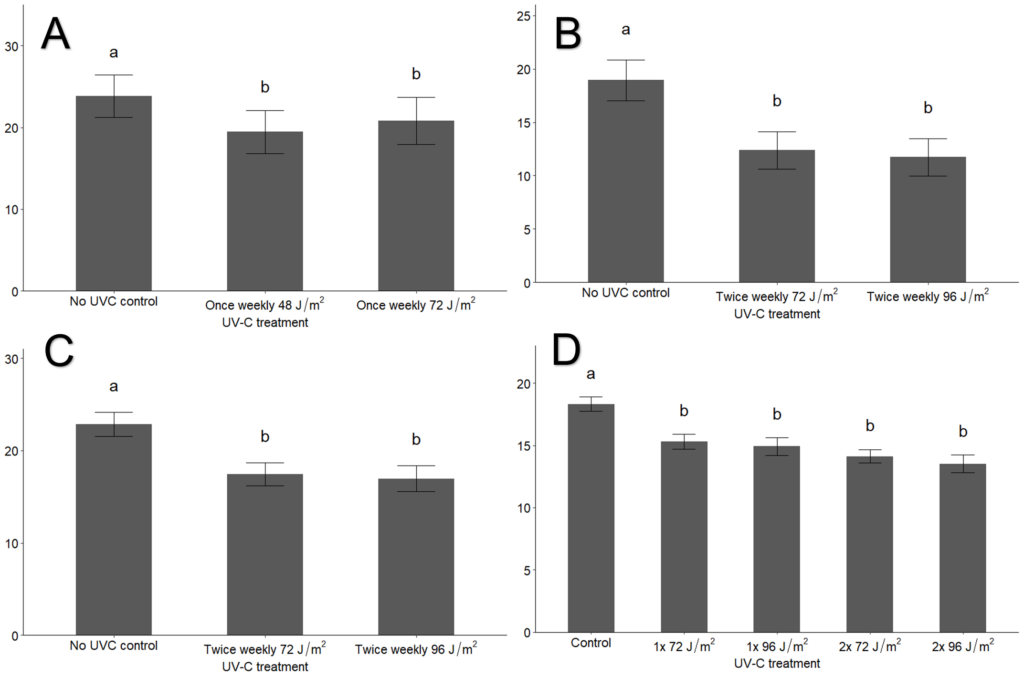

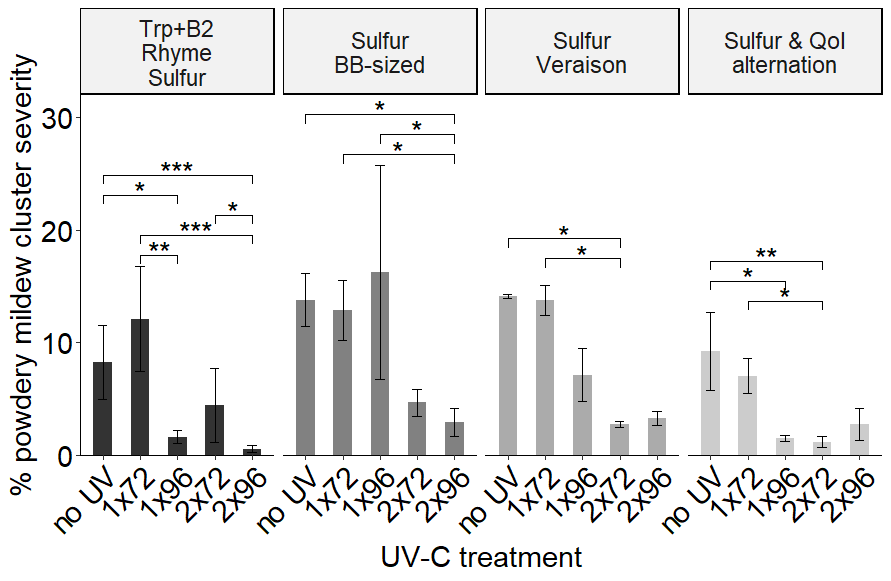
Only in 2023 was the effect of UV-C significant for detected inoculum from glove swabs. Interestingly, only in 2020 was there a significant effect of fungicide on the proportion of QoI resistant E. necator from glove swab samples. Applying a QoI every 14 days resulted in no fully CYTB wild-type samples being detected at the end of the 2020 season with almost 40% of samples detecting the mutation. However, even with multiple applications of a QoI in each season after 2020, the proportion of QoI resistant samples detected decreased to 18.6, to 0.8, to 5.3% in the following years. This is opposite to what we expected based on the laboratory tolerance of CYTB mutant-type being greater than that of wild-type, as well as prior work by Lowder et al (2023).
There was no effect of UV-C on Botrytis bunch rot in any year of the study, suggesting that although laboratory trials showed obtainable efficacy of UV-C, this technology is likely not feasible for field management.
Objective 3. Examine the suitability of an autonomous robotic platform to deliver UV-C applications at a commercial scale.
The SAGA robotic array was found to not be robust enough for vineyard use in its current development. Issues discovered included: not being water and dust tight, difficulty with slopes (up or cross slopes), and common loss of wheel alignment due to rough terrain. Future directions will be focused on optimizing and improving the robotic array as well as using either autonomous electric tractors or converted autonomous diesel tractors as the delivery system. We will be working with George Fox University and their Senior Design Program to reimagine the robotic system and develop a 2-row UV-C tractor array with potentially more powerful lights designed by Puren Solutions. The intention is to have the new array mounted to an autonomous tractor at the WVV site in the 2024 season.
Objective 4. Determine the impact of UV-C application on fruit chemistry.
The brix content, pH, anthocyanin, and phenolic levels of whole grape berry homogenates were not significantly different across the UV-C treatments for fruit for all field trials. There was only one incidence where the interaction of UV-C and fungicide was significant, however, no comparisons were found to be significant. These results over the four years of the study indicate that the UV-C treatments will likely not be detrimental to the fruit quality, and in turn, crop value.
Conclusions
These results suggest that UV-C treatments, in conjunction with fungicide programs and other integrated pest management strategies, may have the potential to allow growers to use fewer fungicides or increase spray intervals between applications. Reducing fungicide applications would save growers on input costs associated with fungicide applications, and the environmental inputs from fungicide applications. Even though UV-C offers promising improvement in powdery mildew disease control, the application of UV-C must be made more economically feasible for commercial use, thus future work will continue to examine the use of autonomous robotic platforms for the application of UV-C.
References
- Bindon, K. A., Kassara, S., Cynkar, W. U., Robinson, E. M. C., Scrimgeour, N., and Smith, P. A. 2014. Comparison of extraction protocols to determine differences in wine-extractable tannin and anthocyanin in Vitis vinifera l. cv. Shiraz and Cabernet Sauvignon grapes. J. Agric. Food Chem. 62:4558–4570.
- Lowder, S. R., Neill, T., Peetz, A., Miles, T. D., Moyer, M., Oliver, C., Stergiopoulos, I., Ding, S., and Mahaffee, W. F. 2023. A rapid glove-based inoculum sampling technique to monitor Erysiphe necator in commercial vineyards. Plant Disease 107:3096–3105.
- Mercurio, M. D., Dambergs, R. G., Herderich, M. J., and Smith, P. A. 2007. High throughput analysis of red wine and grape phenolics - Adaptation and validation of methyl cellulose precipitable tannin assay and modified somers color assay to a rapid 96 well plate format. Journal of Agricultural and Food Chemistry 55:4651–4657.
- Miles, T. D., Neill, T. M., Colle, M., Warneke, B. W., Robinson, G., Stergiopoulos, I., and Mahaffee, W. F. 2021. Allele-specific detection methods for QoI fungicide-resistant Erysiphe necator in vineyards. Plant Disease 105:175–182.
- Rantsiou, K., Giacosa, S., Pugliese, M., Englezos, V., Ferrocino, I., Río Segade, S., Monchiero, M., Gribaudo, I., Gambino, G., Gullino, M. L., and Rolle, L. 2020. Impact of chemical and alternative fungicides applied to grapevine cv Nebbiolo on microbial ecology and chemical-physical grape characteristics at harvest. Frontiers in Plant Science 11:1–16.
- Ritz, C., Baty, F., Streibig, J. C., and Gerhard, D. 2015. Dose-Response Analysis Using R ed. Yinglin Xia. PLoS ONE 10:1–13.
- Sanzani, S. M., Schena, L., De Cicco, V., and Ippolito, A. 2012. Early detection of Botrytis cinerea latent infections as a tool to improve postharvest quality of table grapes. Postharvest Biology and Technology 68:64–71.
- Thiessen, L. D., Keune, J. A., Neill, T. M., Turechek, W. W., Grove, G. G., and Mahaffee, W. F. 2016. Development of a grower-conducted inoculum detection assay for management of grape powdery mildew. Plant Pathology 65:238–249.
- Vidal-Diez de Ulzurrun, G., Huang, T. Y., Chang, C. W., Lin, H. C., and Hsueh, Y. P. 2019. Fungal feature tracker (FFT): A tool for quantitatively characterizing the morphology and growth of filamentous fungi. PLoS computational biology 15:1–20.
Research Outcomes
The results from the small plot trials in Oregon indicate that UV-C is unlikely to be a standalone replacement for fungicides in the Willamette Valley for the management of powdery mildew. However, the reduced development of disease in the UV-C treated vines does indicate that UV-C could be another useful tool in the integrated pest management toolbox. The results from the small plot trials justify scaling the project up to a commercial scale with commercial management practices. In the commercial setting, there would not be intentionally untreated vines that act as an inoculum source, lowering the overall disease pressure.
To be a feasible option for grower adoption, the technology must be made more cost effective. The limited window of effective application time at night and the cost associated with frequent applications required to be efficacious are major limitations in the feasibility of using UV-C for the cost-effective management of vineyard disease. The use of autonomous robotic platforms can reduce the associated costs, making the technology a more feasible tool for disease management. However, there are still technological hurdles to overcome for the robotic platforms to be reliably used in Willamette Valley vineyards.
Education and Outreach
Participation Summary:
Alex and Walt have presented UV-C research at the following events:
- American Phytopathological Society Pacific Division meeting 2021: Virtual presentations by the graduate students showcasing their research. Most participants were academic researchers.
- OWRI Spring webinar 2021: A virtual seminar series focusing on the research of the members of the Oregon Wine Research Institute with 25 people attending the virtual seminar session. https://media.oregonstate.edu/media/t/1_hxxggy76
- Sustainable Agriculture Expo 2021: The Sustainable Ag Expo is a 6-week of virtual learning seminar and tradeshow that provides an opportunity for farmers, ag professionals, and pest control advisors to learn about the latest in farming research, resource issues, and business trends related to sustainable agriculture. Of the 121 participants in the course, 101 completed the course and took a quiz on the content and passed.
- Grape Day 2022: Grape Day is an annual event run by the Oregon Wine Research Institute at Oregon State University highlighting research relevant to the Oregon wine industry. The goal is to provide industry members with an opportunity to network and discuss research with our researchers and invited speakers. There were 118 participants, with a mix of growers, ag professionals, and researchers. https://owri.oregonstate.edu/sites/agscid7/files/owri/wong_2022grapeday_owri.pdf
- Vineyard Technology Field Day 2022: An annual event run by the OSU Viticulture Extension, USDA-ARS, and Willamette Valley Vineyards to demo emerging technologies and innovations in disease management, vineyard nutrient monitoring, crop estimation, and alternative-powered tractors. There were 100 participants, most of which were growers. https://extension.oregonstate.edu/events/vineyard-technology-field-day https://files.constantcontact.com/27fc1a43201/49fbccf2-1542-4dd4-b6dc-6b44965e7233.pdf
- International Workshop on Grapevine Downy and Powdery Mildews: An international workshop on recent research on powdery and downy mildew of grapevines. There were approximately 75 participants, comprised of mostly researchers.
- Science Pub April 2023. Oregon State University run event for the general public. Graduate students present their research to the general public in short lightning talks. Plants the Night Away! - Oregon State University
- Napa Valley Technical Group meeting (Virtual attendance). June 15th, 2023. A monthly meeting of the Napa Valley Technical Group wine makers where graduate students from Oregon State, Cornell, and Fresno gave lighting talks on their research topic. Napa Valley Wine Technical Group - Meeting/Event Information (nvwtg.org)
- American Phytopathological Society National meeting 2023 in Denver CO., comprised mostly of academic and industry individuals.
- LIVE annual meeting. Comprised of ~57 growers and ~10 ag professionals
- Sonoma Grape Growers Association meeting with 186 in attendance
- Costal Viticulture Consultants meeting with 43 in attendance
- Easter Oregon Growers meeting with 57 in attendance
- PhD defense seminar. July 27th, 2023. Public defense seminar to present research finding during graduate career. Most participants are academic researchers.
Publications:
Wong, A., Gadoury, D., Mahaffee, W., Evaluation of germicidal UV-C light for suppression of grape powdery mildew and Botrytis bunch rot in Western Oregon. Plant Disease. (In submission)
Wong, A. and Mahaffee, W., Shining bright under pressure? Germicidal ultraviolet light for the management of grape powdery mildew in the Willamette Valley of Oregon, American Phytopathological Society Plant Health 2023, Denver, CO, August 12-16th, 2023
Wong, A. and Mahaffee, W., Ultraviolet Spectrum‑C Light as a Tool to Manage Grape Powdery Mildew, OWRI Vine to Wine, January 2023
Wong, A. and Mahaffee, W., A bright idea? Ultraviolet light as an integrative pest management tool for grape powdery mildew, OWRI Vine to Wine, November 2020
We have also provided information, consultations, and/or tours on the UV-C array design and research results to ten individuals.
There have attended two field days hosted at Willamette Valley Vineyards for growers (~100 growers each event) that also had and local TV stations covering the events. WVV has also published press releases to show the UV-C array technology being used on site.
This project has reached a wide range of individuals who include, but are not limited to growers, extension specialists, academic and industry researchers, and the public. We have presented our research results as well as held live demonstrations at multiple events to reach a wide group of growers. In addition, we have had individual growers visit for demonstrations to see the UV-C technology.
Outreach to growers has emphasized the transparency of the efficacy results and limitations of the UV-C technology to manage disease. The results from the WSARE survey have indicated that growers are interested in the technology, but the limitations (e.g. limited application window, lack autonomous platform and uncertain safety requirements/liability) are probably still a large barrier to future adoption. All the growers who participated in the WSARE survey indicated a gain in awareness and knowledge, with 81% of growers indicating that their opinions or attitudes were modified. However, only 5% of growers indicated that there was interest in adopting the technology, with 25% having a neutral opinion, and 70% not interested in currently adopting UV-C into their disease management practices. To improve the willingness to adopt UV-C into the commercial vineyard, more work is needed to 1) show that this technology can be cost effective in managing disease, and 2) demonstrate the usability of the technology with the equipment that vineyards currently have.